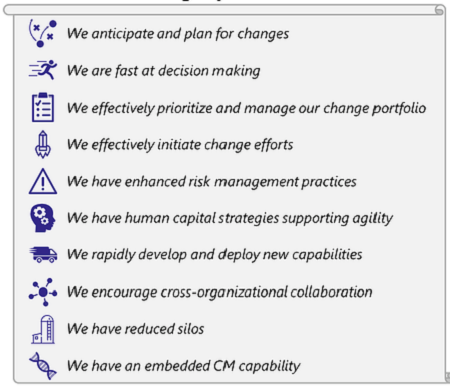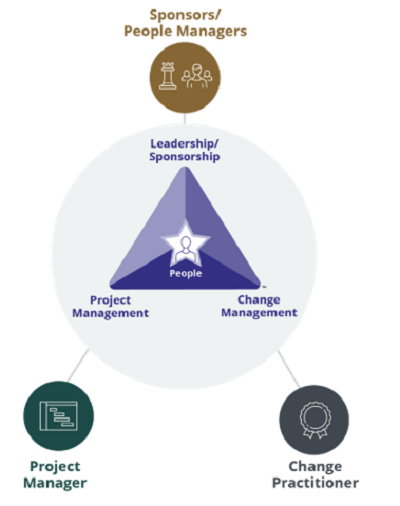(Successful Change Management -11 Elements Cont. 1)
3. Expect and engage change (instead of anxiety and fear, people feel excitement about change; develop change agility, ie its 6 components:
"...1. Always present ability in the fabric of the organisation
2. Out-changing the competition
3. Anticipating/tuned into coming changes
4. Increasing speed/quickness at change
5. Both proactive (planned) and reactive (unplanned)
6. Minimal disruption; not side-lining you..."
Prosci, 2023a)
Agility attributes

(source: Prosci, 2023a)
NB
"...9 out of 10 executives say organisational agility is critical to business success..."
Prosci, 2023l
4. Change is part of the job (participating in the change process is an important part of the job; have the capability to handle this; metrics in place to measure performance in change
"...the ultimate goal of change management is to drive the organisation, results and outcomes by engaging employees and inspiring them to adopt a new way of working......a project or initiative can only be successful if the individual employees change their behaviours. And to manage change successfully roles must defined......from the highest level of leadership to front-line employees through the transition..."
Prosci, 2023b

(source: Prosci, 2023b)
The table below describes a core role from the perspective of the first group executing it; it illustrates what each individual will do by stating that they understand their role and are actively engaged in managing change; also, what they might state if they do not fully understand the role.
| Role |
Importance | Understand role |
Don't understand role |
| Change practitioner (enabling) |
- focus on people side - adequately resourced - areas of responsibility & accountability are known |
I contribute to successful change outcomes through adoption & usage by preparing, equipping & supporting people with integrated strategies & plans. | I feel isolated like an island. People expect me to do everything & have all the answers. |
| Sponsor (employee-facing) |
- need to be active & visible - articulate commitment to change - have authority |
I contribute to successful change outcomes through adoption & usage by active, visible participation throughout, building coalitions & communicating directly | I gave you the funds & signed the charter, now go make it happen. |
| People managers (employee-facing) |
- close to the front-line staff who have to make change work - support staff - their attitude & actions will influence what their people do |
I contribute to successful change outcomes through adoption & usage by performing the role of communicator, liaison, advocate, resistance manager and coach. | I am concerned about the negative impacts of the change on myself & others. I wish I knew what was going on. |
| Project manager (enabling) |
- focus on technical side, ie project's design, development & delivery - adequately resourced with people, funds, time, etc |
I contribute to successful change outcomes by designing with adoption & usage in mind & integrating with the people side | My focus is getting to go live; once this happens I'm moving on to the next project |
| People/impacted employees |
- focus on people side by helping people adapt to change - individuals have to change to achieve desired outcomes |
I contribute to successful change outcomes by engaging, adopting & using the change | I'm going to wait & see what happens as it seems like this change & its success are not my responsibility |
(main source: Prosci, 2023b)
NB The project managers and sponsor have direct contact with the front line employees impacted by the change; in contrast, change practitioner and project manager do more of the work behind the scenes as facilitators, ie need to work with and through others and quietly guide others to successful outcomes.
Some other roles that could be needed include internal communications training experts, human resource business partners, organisation development staff, business analysts, subject matter experts, change agent networks, solution developers, etc.
More on each role, ie must do
a) change Practitioner
i) apply structured, proven change management methodology (but at the same time, be flexible and agile as 'no-one-size-fits-all')
ii) formulate strategy (evaluate the size of the change and its impact on people so that strategies for handling the people side are developed)
iii) support other roles (be like a coach and/or 'go-to-person' to help others in the change process)
b) sponsors
i) should participate actively and visibly throughout the life of the project (always actively supporting and visible, ie from start to finish of the initiative)
ii) build a coalition of support (build and maintain a network of leaders and influencers who give the change credibility and priority)
iii) communicate directly with employees (explain business reasons for the change to employees; communicate, support and promote change to impacted groups)
c) people managers (eg managers and supervisors) should:
i) communicate (employees prefer to hear from people they report directly to about impacts of the change)
ii) liaise (interacting with management and staff, ie taking directions and providing feedback)
iii) advocate (owing to their influence with their staff, people managers need to be on side with the change so that they become change champions))
iv) resistance manager (immediate supervisors have the most influence on staff because they know their people best and can work to prepare, quick and support them based on the unique needs and challenges of the project)
v) coach (helping their staff through the change process)
d) project managers (generally focus on the technical side
i) designing the actual change (generate solutions that impacts on how people do their jobs)
ii) managing the technical side
"... leverage from the project charter, business case, schedule, essential resources, work breakdown structure, budget, etc..."
Prosci, 2023b
iii) engaging with the change practitioner (integrating the technical and people side so that these elements move forward in unison)
iv) integrating change management plans with project plan (integrate as early as possible to create a single, seamless project plan))
e) people/impacted employees (need to
i) actively participate in the change (as a result , the change initiative is more easily adopted)
ii) understand emotional responses to change (even though everyone is unique, there are some predictable ways that people react to change, eg if people have the buy-in, ownership of the change, and it is their change process, not senior management's and/or consultants', then they are more likely to actively participate; encourage people to take control of their change experience)
Extended roles with complimentary functions may be required to help design, develop and deliver solutions for more engaging, adopting, implementing, etc. this will help maintain strategic alignment broader organisational goals. Some examples:
- extra experience and expertise, eg understanding past changes that are applicable to the current situation
- specialised knowledge that is required by the change initiative
- specific techniques and tools that are required for the change initiative))
